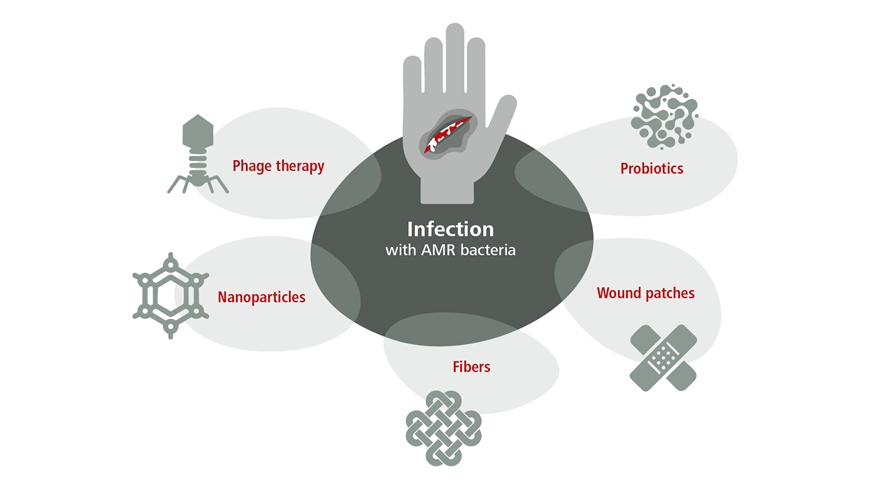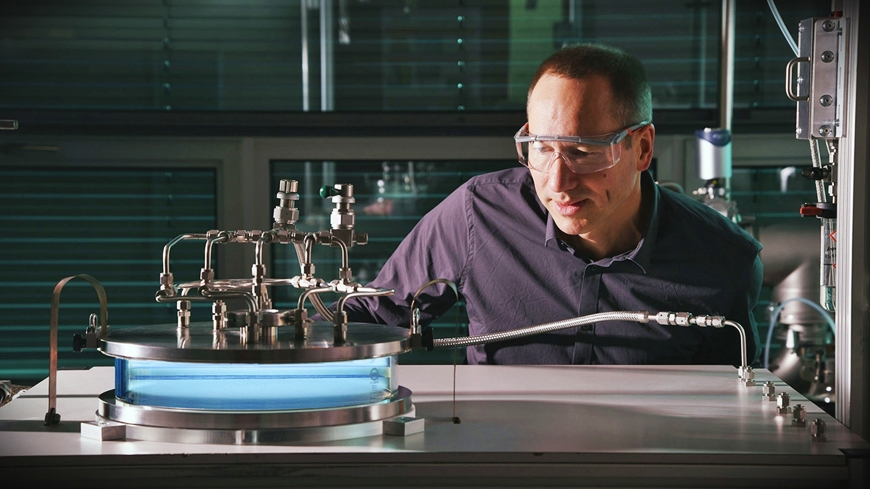Therapy of infections with antibiotic-resistant bacteria
The treatment of infections with antibiotic-resistant (AMR) bacteria is a major challenge. As more and more bacteria are becoming resistant to existing antimicrobial agents, the arsenal of effective antibiotics for therapy is shrinking rapidly. Empa researchers are therefore working on various strategies to develop innovative materials and technologies that enable effective treatments for AMR infections.

What are the current problems with AMR bacterial infections?
One of the biggest problems is the lack of new effective antibiotics, as pathogens are increasingly resistant to conventional drugs. This crisis is exacerbated by long development times for new antibiotics and the high costs associated with bringing new drugs to market. To overcome resistance, high-dose or combination therapy can be attempted, but there is a risk of harmful or even toxic effects. Alternative or less frequently used antibiotics are in some cases a chance to combat an infection with resistant pathogens. However, such "drugs of last resort" should be used as rarely as possible to prevent further development of resistance (“the more you use it, the quicker you lose it”). Complementary therapies, e.g. strengthening the immune response, are currently being tested.
What new strategies are available for treating infections with AMR pathogens?
Empa researchers are pursuing various new strategies in the treatment of AMR infections. The overall goal of these developments is to increase the effectiveness of therapies and reduce the risk of developing resistance. These include active substances such as reactive oxygen species and functional nanoparticles that can minimize the development of resistance and attack resistant bacteria. Bacteriophages, i.e. viruses that specifically target bacteria, are also being researched. They have already been successfully used in practice to treat multi-resistant bacteria. Empa researchers are also working with probiotic bacteria such as lactobacilli to combat antibiotic resistance. Such probiotics are promising “living materials” as they have several mechanisms to kill bacteria and eliminate biofilms, e.g. the secretion of bacteriocins, chemical compounds that interfere with biofilm formation. Another group of substances that are effective against bacteria are antimicrobial peptides. With their unique mechanism of action, these protein building blocks destroy bacterial membranes and can thus also combat resistant pathogens. To ensure that new antimicrobial agents can be used locally in high concentrations and with minimal toxicity, researchers are also working on new biomaterials as carrier substances for wound dressings, for instance.

Selected research projects on treating AMR infections
DeliCat
DeliCat - Delivery of Reactive Oxygen Species through a Catalytic Transport Layer
Living antimicrobial materials
SNF: Partnership against Biofilm-associated Expression, Acquisition and Transmission of AMR
Advanced Healthcare Materials: An Injectable Living Hydrogel with Embedded Probiotics as a Novel Strategy for Combating Multifaceted Pathogen Wound Infections
Nanovision
NOVA
NOVA | Home
RIC-2D
T
Silver polymer fibers
Empa researchers are developing nanocomposites made of silver and polymer fibers. The specially optimized process is designed to work without solvents and nanomaterial precursors, making it environmentally friendly and industrially scalable. The goal: antimicrobial materials based on silver-containing nanocomposites.
Polymer-assisted in-situ thermal reduction of silver precursors: A solventless route for silver nanoparticles-polymer composites
Living materials
Dr. Qun Ren
Biointerfaces
Phone +41 58 765 7688
Antimicrobial coatings
Dr. Dirk Hegemann
Advanced Fibers
Phone +41 58 765 7268
Nanomaterials
Dr. Giacomo Reina
Particles-Biology Interactions
Phone +41 58 765 7344
-
Share
